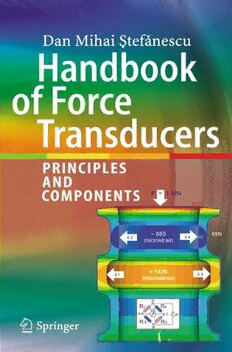Download Handbook of Force Transducers: Principles and Components PDF Free - Full Version
Download Handbook of Force Transducers: Principles and Components by Dan Mihai Ştefănescu (auth.) in PDF format completely FREE. No registration required, no payment needed. Get instant access to this valuable resource on PDFdrive.to!
About Handbook of Force Transducers: Principles and Components
Part I introduces the basic "Principles and Methods of Force Measurement" according to a classification into a dozen of force transducers types: resistive, inductive, capacitive, piezoelectric, electromagnetic, electrodynamic, magnetoelastic, galvanomagnetic (Hall-effect), vibrating wires, (micro)resonators, acoustic and gyroscopic. Two special chapters refer to force balance techniques and to combined methods in force measurement. Part II discusses the "(Strain Gauge) Force Transducers Components", evolving from the classical force transducer to the digital / intelligent one, with the incorporation of three subsystems (sensors, electromechanics and informatics). The elastic element (EE) is the "heart" of the force transducer and basically determines its performance. A 12-type elastic element classification is proposed (stretched / compressed column or tube, bending beam, bending and/or torsion shaft, middle bent bar with fixed ends, shear beam, bending ring, yoke or frame, diaphragm, axial-stressed torus, axisymmetrical and voluminous EE), with emphasis on the optimum location of the strain gauges. The main properties of the associated Wheatstone bridge, best suited for the parametrical transducers, are examined, together with the appropriate electronic circuits for SGFTs. The handbook fills a gap in the field of Force Measurement, both experts and newcomers, no matter of their particular interest, finding a lot of useful and valuable subjects in the area of Force Transducers; in fact, it is the first specialized monograph in this inter- and multidisciplinary field.
Detailed Information
| Author: | Dan Mihai Ştefănescu (auth.) |
|---|---|
| Publication Year: | 2011 |
| ISBN: | 9783642182952 |
| Pages: | 643 |
| Language: | English |
| File Size: | 26.866 |
| Format: | |
| Price: | FREE |
Safe & Secure Download - No registration required
Why Choose PDFdrive for Your Free Handbook of Force Transducers: Principles and Components Download?
- 100% Free: No hidden fees or subscriptions required for one book every day.
- No Registration: Immediate access is available without creating accounts for one book every day.
- Safe and Secure: Clean downloads without malware or viruses
- Multiple Formats: PDF, MOBI, Mpub,... optimized for all devices
- Educational Resource: Supporting knowledge sharing and learning
Frequently Asked Questions
Is it really free to download Handbook of Force Transducers: Principles and Components PDF?
Yes, on https://PDFdrive.to you can download Handbook of Force Transducers: Principles and Components by Dan Mihai Ştefănescu (auth.) completely free. We don't require any payment, subscription, or registration to access this PDF file. For 3 books every day.
How can I read Handbook of Force Transducers: Principles and Components on my mobile device?
After downloading Handbook of Force Transducers: Principles and Components PDF, you can open it with any PDF reader app on your phone or tablet. We recommend using Adobe Acrobat Reader, Apple Books, or Google Play Books for the best reading experience.
Is this the full version of Handbook of Force Transducers: Principles and Components?
Yes, this is the complete PDF version of Handbook of Force Transducers: Principles and Components by Dan Mihai Ştefănescu (auth.). You will be able to read the entire content as in the printed version without missing any pages.
Is it legal to download Handbook of Force Transducers: Principles and Components PDF for free?
https://PDFdrive.to provides links to free educational resources available online. We do not store any files on our servers. Please be aware of copyright laws in your country before downloading.
The materials shared are intended for research, educational, and personal use in accordance with fair use principles.

